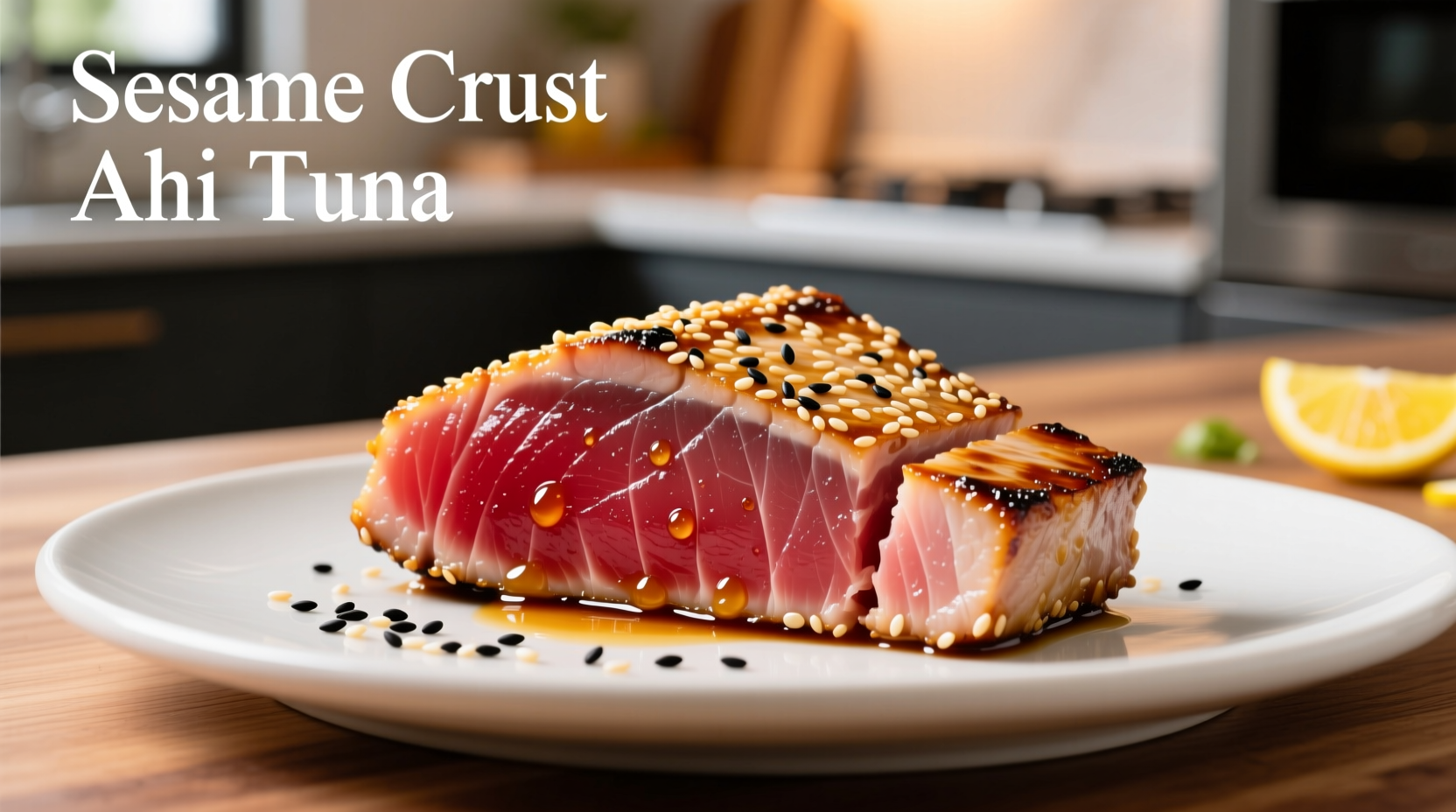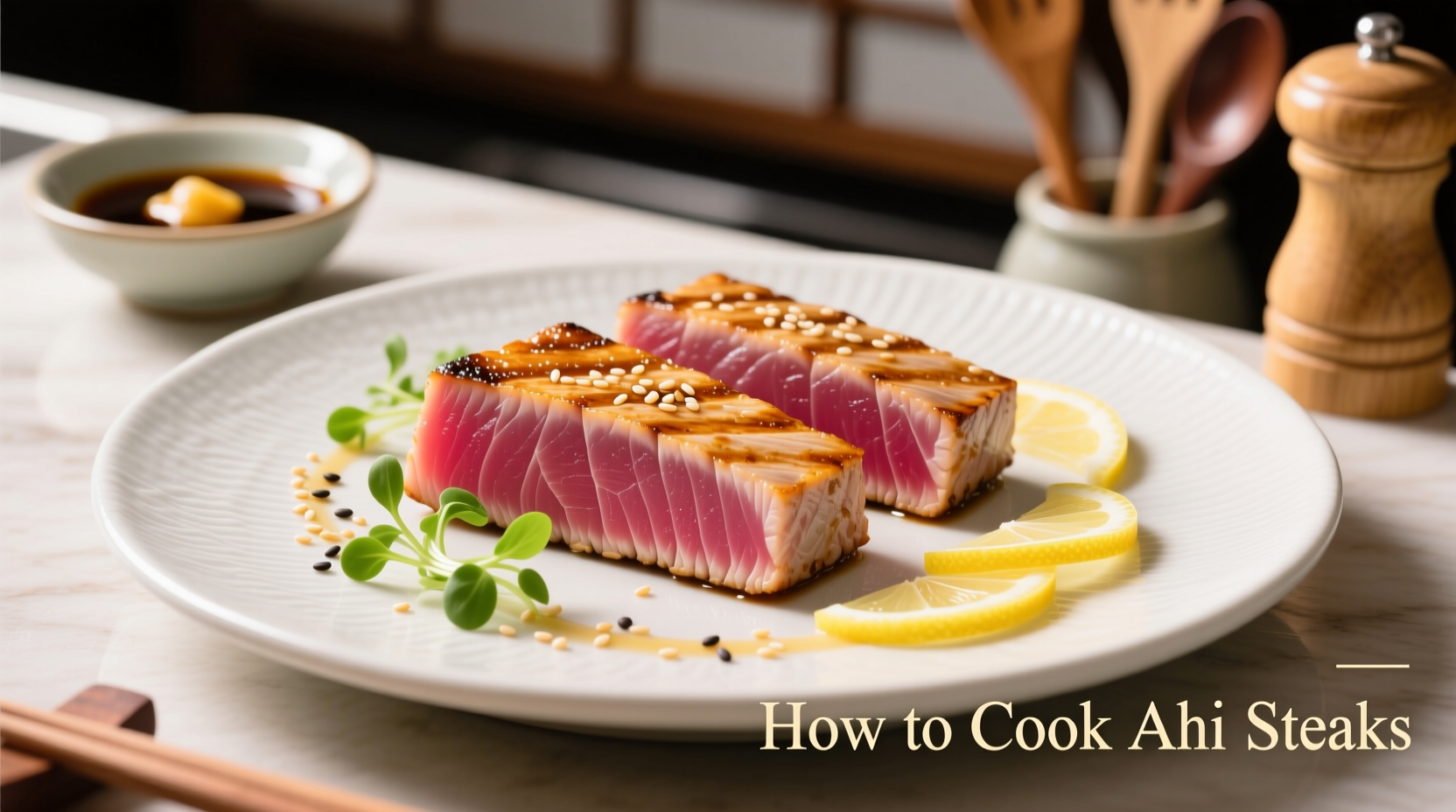Perfectly seared ahi tuna steaks with a crisp exterior and rare center require just 90 seconds per side on high heat. Key factors include using 1-1.5 inch thick steaks, bringing fish to room temperature, patting completely dry, and using a smoking hot pan with high smoke point oil. Never cook ahi beyond medium-rare to preserve its delicate texture.
Mastering ahi tuna steak preparation transforms an expensive cut into a restaurant-quality meal at home. Unlike most fish, ahi (yellowfin tuna) is best served with a cool, raw center and caramelized crust—similar to a beef filet. This guide delivers professional chef techniques you can implement immediately, whether you're cooking for a special occasion or elevating weeknight dinners.
Understanding Ahi Tuna Quality Before You Cook
Selecting premium fish is non-negotiable for safe, delicious results. The FDA recommends verifying these quality indicators:
| Quality Indicator | Acceptable | Avoid |
|---|---|---|
| Color | Bright cherry red | Brown, dull, or inconsistent hues |
| Texture | Firm with slight spring-back | Mushy or leaving indentation |
| Smell | Clean ocean scent | Strong fishy or ammonia odor |
| Origin Label | "Sashimi-grade" or "For raw consumption" | No specification |
The NOAA FishWatch program confirms that proper handling from catch to counter prevents histamine formation, which causes scombroid poisoning. Always purchase from reputable fishmongers who maintain a 32-38°F (0-3°C) cold chain.
Essential Preparation Steps for Perfect Searing
Professional results begin before the fish hits the pan:
- Temperature equilibrium: Remove steaks from refrigerator 30 minutes before cooking. Cold fish resists even searing.
- Dry surface is critical: Pat aggressively with paper towels—moisture creates steam instead of crust.
- Salt timing: Season with kosher salt 10 minutes pre-cooking to draw surface moisture away.
- Oil selection: Use avocado oil (smoke point 520°F/270°C) or refined coconut oil—extra virgin olive oil burns at searing temperatures.

The 4-Minute Searing Technique That Never Fails
Follow this timed method for consistent results:
- Heat cast iron or carbon steel pan over high heat for 5 minutes until smoking
- Add 1 tbsp high-smoke point oil and swirl to coat
- Place seasoned steaks in pan—should sizzle immediately
- Cook undisturbed for 90 seconds for 1-inch thickness (2 minutes for 1.5-inch)
- Flip using fish spatula and sear second side 90 seconds
- Optional: Sear edges 15-20 seconds each for crust
- Rest 2 minutes before slicing against the grain
The CDC's food safety chart confirms ahi reaches safe consumption at 115°F (46°C) internal temperature—well below traditional fish guidelines because it's consumed rare. Use an instant-read thermometer at the thickest point:
- Rare: 115°F (46°C) - cool red center (recommended)
- Medium-rare: 125°F (52°C) - warm red center
- Medium: 135°F (57°C) - warm pink center (maximum recommended)
Avoiding Costly Mistakes That Ruin Ahi Steaks
Even experienced cooks make these preventable errors:
- Overcrowding the pan: Causes temperature drop and steaming instead of searing
- Moving fish prematurely: Creates uneven crust and sticking—wait for natural release
- Overcooking: Ahi becomes dry and chewy beyond 135°F internal temperature
- Skipping rest time: Slicing immediately loses precious juices
- Using wet seasonings: Teriyaki or citrus marinades create steam barriers
For safety, the FDA's FoodSafe Charts emphasize that raw or rare fish carries higher risk for immunocompromised individuals, pregnant women, and children under 5. These groups should cook ahi to 145°F (63°C) with no translucent areas.
Flavor Pairings That Elevate Simple Ahi Steaks
Complement rather than overwhelm the delicate flavor:
- Before cooking: Light coating of toasted sesame seeds or crushed black pepper
- After cooking: Citrus beurre blanc, wasabi aioli, or mango-avocado salsa
- Accompaniments: Coconut rice, roasted asparagus, or cucumber salad
- Wine pairing: Crisp Sauvignon Blanc or dry Rosé
Remember that ahi's natural umami flavor shines brightest with minimal seasoning. Professional chefs like those at Thomas Keller's seafood establishments use only sea salt and cracked pepper to showcase premium tuna's inherent quality.
Frequently Asked Questions
Can I cook frozen ahi tuna steaks without thawing?
No—cooking frozen ahi creates uneven results with a burnt exterior and frozen center. Thaw steaks overnight in the refrigerator on a wire rack over a tray. Never thaw at room temperature to prevent bacterial growth in the USDA's "danger zone" (40-140°F).
Why does my ahi steak stick to the pan?
Sticking occurs when the pan isn't hot enough before adding fish or when moving the steak too soon. Ensure your pan is smoking hot and allow the initial 90-second sear to create a natural non-stick crust through the Maillard reaction before attempting to flip.
How do I know if my ahi tuna is fresh enough for rare preparation?
Only purchase fish explicitly labeled "sashimi-grade" or "for raw consumption" from trusted sources. Fresh ahi should have bright red color, firm texture that springs back when pressed, and a clean ocean smell—not fishy or ammonia-like. If unsure, cook to 125°F internal temperature rather than rare.
What's the ideal thickness for pan-seared ahi steaks?
One to one-and-a-half inches is optimal. Thinner cuts overcook before developing a proper crust, while thicker pieces (over 2 inches) require oven finishing which compromises the sear. Most restaurants use 1.25-inch steaks for perfect rare centers with crisp exteriors.
Can I use olive oil for searing ahi tuna?
Regular extra virgin olive oil has a low smoke point (325°F) and will burn at searing temperatures. Use refined avocado oil (smoke point 520°F) or light olive oil (smoke point 465°F) instead. Save extra virgin for finishing drizzles after cooking.











 浙公网安备
33010002000092号
浙公网安备
33010002000092号 浙B2-20120091-4
浙B2-20120091-4